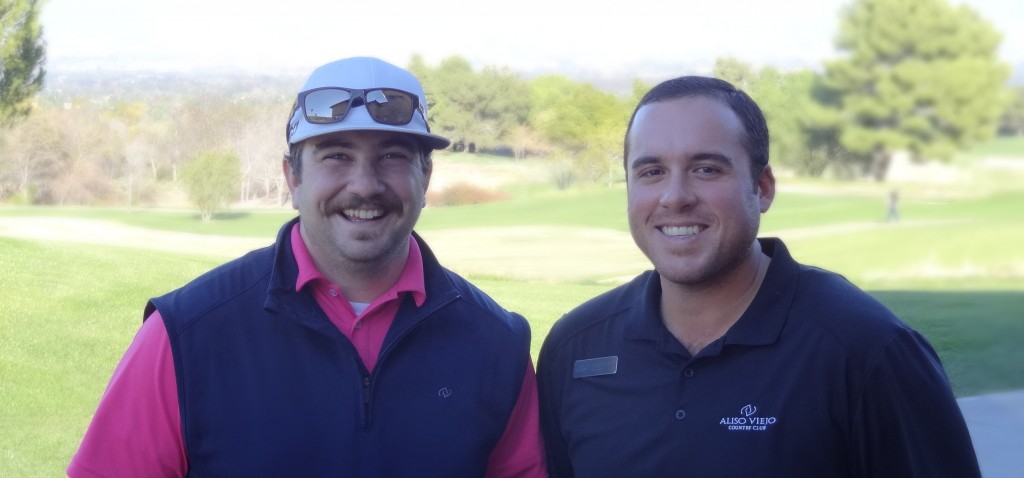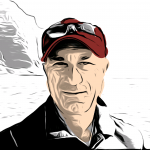Lots of people find themselves in jobs or professions that, admittedly, they don’t like. The work simply doesn’t excite them. Maybe they do it because they feel that their job is where the money is. But it doesn’t have to be that way. As the noted professor and lecturer Joseph Campbell, wrote:
“If you do follow your bliss you put yourself on a kind of track that has been there all the while, waiting for you, and the life that you ought to be living is the one you are living. Follow your bliss and don’t be afraid, and doors will open where you didn’t know they were going to be.”
This is a tale of two young men who are “following their bliss.”
Sean Penny
Around his 11th birthday, Sean Penny’s father joined a country club in Colorado, and Sean was introduced to the game of golf. The head pro was “the man,” and according to Sean, “He seemed like a good guy, and it seemed like he made a good living, and I liked how he was involved with everything at the club.” So was born the idea that Sean would grow up to be a professional golfer; not an astronaut, or a cowboy, or a fireman, but a golf pro. It went from being simply a neat idea to something he seriously considered as a way to make a living after he graduated from the University of Northern Colorado as a Business major. Sean realized he didn’t have any idea what he was going to do with his Business degree, and began throwing some possibilities around with his dad. He’d worked during the summers as a pro shop assistant at a golf course in Colorado, so the idea of a career in golf was resurrected. He found the Professional Golfers’ Career College in Temecula, California, and the next thing you know, he was at the golf school. Sixteen months later he graduated from the golf school, and within a month he found a job as an Assistant Golf Professional at Aliso Viejo Country Club in Aliso Viejo, CA.
Casen Burwell

Casen Burwell also found his way to the pro shop at Aliso Viejo CC, but his path was very different. He’d focused on baseball until he was 20 years old, but quit the sport while he was still in school. He got a job as a valet, parking cars at Tustin Ranch Golf Club, simply as a way to get some extra cash in his pocket. He got interested in playing golf because his baseball buddy, MLB power-hitter Mark Trumbo [traded this week by the LA Angels to the Arizona Diamondbacks], started playing golf during the off-season, and Casen picked up the game so he could play along with Trumbo. According to Casen, “The more I got to play with the guys, the more I fell in love with the game, especially hitting my driver.” It turns out that Casen has a real talent for hitting a golf ball a long way–350 yards or more–and once his golfing buddies helped him learn enough technique to harness his power and hit the ball reasonably straight, he decided to test his skill at a Long-Drive Competition. He did so well that, for the next four years, he was a regular participant in Long-Drive Competitions, winning several of them. But his love for all aspects of the game, not just crushing the ball out of sight, brought him to Aliso Viejo CC in August, 2009, where he hoped to pursue his dream of becoming a card-carrying PGA Professional.
 Of course, there’s a huge difference between being a Class-A PGA Professionl and being a PGA Tour player, like Tiger Woods. PGA Tour players have to do one thing, but they have to do it at a world-class level: shoot low scores on very difficult golf courses, and do it day in and day out. Fewer than 400 players have the skill, grit and confidence needed to qualify to play on one of the PGA Tours in any given year. But most of the PGA Tour members, despite their superior golfing ability, wouldn’t qualify to join the over 27,000 Class A PGA Professionals, because most PGA Tour players haven’t studied all of the myriad aspects of managing a golf club, running a staff, dealing with members, giving lessons, fitting and repairing golf clubs, and then demonstrated those skills through testing and practical work experience.
Of course, there’s a huge difference between being a Class-A PGA Professionl and being a PGA Tour player, like Tiger Woods. PGA Tour players have to do one thing, but they have to do it at a world-class level: shoot low scores on very difficult golf courses, and do it day in and day out. Fewer than 400 players have the skill, grit and confidence needed to qualify to play on one of the PGA Tours in any given year. But most of the PGA Tour members, despite their superior golfing ability, wouldn’t qualify to join the over 27,000 Class A PGA Professionals, because most PGA Tour players haven’t studied all of the myriad aspects of managing a golf club, running a staff, dealing with members, giving lessons, fitting and repairing golf clubs, and then demonstrated those skills through testing and practical work experience.
The Apprentices
That’s what Sean and Casen set out to do, when, in January, 2010, they started down the path toward becoming PGA professionals. Before they could get started, they had to pass the PGA’s Playing Ability Test [“PAT”]. For a highly -skilled player, the test might not seem terribly difficult, but according to the PGA, less than 20% of those taking the test achieve a passing score. (As a reference point, to pass the PAT at Aliso Viejo CC, you’d have to play 36 holes in a single day, from the Blue tees–6,247 yards, Course Rating 70.5–in 156 strokes, an average score of 78 strokes per 18 hole round.) According to Sean, “It’s tough; it’s 36 holes and you have no break,” and Casen adds, “You feel a lot of pressure, because you don’t want to have to come back and tell your friends that you didn’t pass your Playing Ability Test.” Casen had previously taken the PAT in 2007 and didn’t pass the test. Sean and Casen both passed the PAT in 2009. While they weren’t PGA Tour material, they weren’t going to embarrass themselves or the PGA when they picked up a golf club to play. They were ready to join the PGA Professional Golf Management Program and become registered PGA Apprentices.
 Over the ensuing three years, Sean and Casen completed Level 1 and Level 2 of the 3-Level PGM Program. At each level they spent hundreds of hours engrossed in self-study coursework, they collected and thoroughly documented hundreds of hours of relevant work experience, and they passed tests on every aspect of golf management (course work has ranged from Business Planning to Swing Analysis, from the PGA Constitution and the Rules of Golf to Golf Car Fleet Management, and from Turfgrass Management to Customer Relations). As a culminating activity at each level, Sean and Casen attended five-day PGA Apprentice Checkpoints at the PGA Education Center in Port St. Lucie, FL, where they took additional tests, participated in simulation exercises, and attended seminars on subject matter they would be tested on at the next level of the program.
Over the ensuing three years, Sean and Casen completed Level 1 and Level 2 of the 3-Level PGM Program. At each level they spent hundreds of hours engrossed in self-study coursework, they collected and thoroughly documented hundreds of hours of relevant work experience, and they passed tests on every aspect of golf management (course work has ranged from Business Planning to Swing Analysis, from the PGA Constitution and the Rules of Golf to Golf Car Fleet Management, and from Turfgrass Management to Customer Relations). As a culminating activity at each level, Sean and Casen attended five-day PGA Apprentice Checkpoints at the PGA Education Center in Port St. Lucie, FL, where they took additional tests, participated in simulation exercises, and attended seminars on subject matter they would be tested on at the next level of the program.
When I interviewed Sean and Casen on December 2, 2013, they were preparing to go to the PGA Education Center in Florida for their Level 3 Checkpoint. By their estimates they’ve invested over 700 hours, worked through more than 2,000 pages of course material, and spent over $12,000 on course materials, program fees and travel costs, not to mention the “lost time” when they weren’t available to work, and had to forego their pay. While in Florida for the Level 3 Checkpoint on December 5th and 6th, they took their final exams on Food & Beverage, Philosophy of Swing Concepts, Merchandising & Inventory, and Supervising & Delegating. They each made a 15-minute presentation to twenty of their peers on a golf-related subject of their choice (Casen gave a presentation on Pace of Play), and had a final “interview” for the golf position they aspire to. As I wrote these words on the evening of December 6th, I expected that the guys were having a drink or two after the Graduation Dinner, celebrating the completion of their apprenticeship and the beginning of their careers as Class A PGA Professionals.
The Golf Pros
Looking to the future, both Sean and Casen indicated that that the next step in their golf careers, having obtained their Class A cards, is to get further experience for a few years working as Assistant Golf Professionals at Aliso Viejo CC, since they both enjoy living in Southern California. They’ll keep their eyes open for the chance to move on to a Head Golf Professional job, should the opportunity arise. For my own sake, I hope they hang around at Aliso Viejo CC for a while, because Sean is my swing coach, and his lessons have helped me play a much steadier and consistent game of golf. In the meantime, I look forward to raising a toast to Sean and Casen when they return with their new, Class-A PGA Professional credentials. They’ve travelled a long, hard road, and I can’t wait to buy them a celebratory libation.


Right on…..Loved this..
Just started working with a young man fresh off the mini-tours who has started the three year run to achieve his Class A card. Hopefully, he will finish on schedule and on the way do wonders for my game.
I hope your Apprentice Pro helps you out as much as Sean has helped me.
Dave – thanks for this article. I had no idea how long a haul that Sean and Cason have gone through.
Chris
Chris,It was a lot of fun writing the article. The best part was the interview with Sean and Case. They are great guys, and both have a wonderful sense of humor.
Wow Mr. Franzetta this is a fantastic article! Very inspiring, I am in Level 1 right now, its not easy! Loved their bios and how you explained the key differences between the PGA tour and PGA of America and what it takes to become Class A.
Madison, glad you enjoyed the article. It was fun writing it, mostly because Sean and Casen are such terrific guys. Best of luck to you on your journey to earn your Class A card. Please share the article with anyone you think might like it.